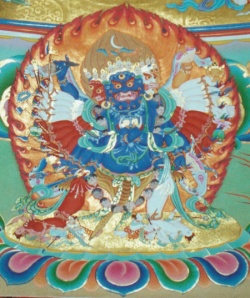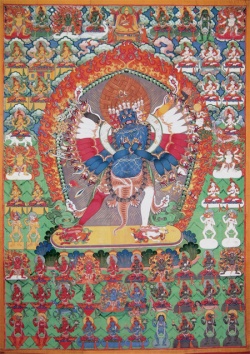Mahāsaṃvara Kālacakra and Vajravega
The first image depicts the wrathful form of Kālacakra, known as Vajravega (rdo rje shugs). This deity features in the main Kālacakra meditation practice in two areas: the protective sphere meditation near the beginning of such practices, and then during the main generation process of Kālacakra he radiates out from the commitment-being to attract the awareness-beings. The second painting shows Vajravega surrounded by the 60 protectors of the protective sphere.
In many ways, Vajravega is similar to Kālacakra. He is black, rather than blue, in colour; he has four faces of the same four colours, but each face is angry and baring the teeth instead of having different expressions. He also has a red right leg and white left leg. As with Kālacakra, he has 24 main hands, holding the same implements as Kālacakra, although these are in wrathful forms where relevant. In addition he has two extra hands; these can clearly be seen above his main white hands in the image. The right one is black and holds the head of a demon, the left is yellow, pointing, and holds a skull of blood; they both hold an elephant skin over his back. He wears ornaments either of vajras or bone, and also of snakes (nāgas).
Towards the end of the fourth chapter of the Vimalaprabhā there is a description of a deity that is identical to Vajravega, except that he is in union with a consort, Viśvamātā. This deity is not named, and is simply called "One holding the fresh elephant skin". He usually goes by the name of Mahāsaṃvara Kālacakra (dus 'khor sdom pa chen po). He is identical in every respect to Vajravega. His consort has one face and two hands, holding a curved knife and human skull of blood. She is yellow in colour and naked, with her hair hanging free.
A couple of pages later in the Vimalaprabhā there is a description of a short practice for the meditation of Vajravega – this time without a consort, and surrounded by eight Nāgas. The text does seem to be treating these two as separate deities, even though the male deities are identical. Some writers, such as Mipham. consider Mahāsaṃvara and Vajravega to be identical, while others, such as Tāranātha, consider them to be distinct.
Perhaps the best way to consider them is that Vajravega, without the consort, is the protector aspect, and Mahāsaṃvara is the yidam. The image on the right is Mahāsaṃvara (The colour green of the consort is presumably the result of changes in the pigmentation – she should of course be yellow.)
Being a yidam, Mahāsaṃvara is naturally associated with a maṇḍala, in which the deity is imagined during the meditation practices. This maṇḍala is very unusual, in that it is circular. It also has eight doorways. This practice is preserved in both the Sakya and Jonang traditions, and the relative dimensions of the maṇḍala in those traditions are somewhat different, although both are circular with eight doorways.



